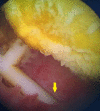An Unusual Cause of Vesical Calculi
- PMID: 32117652
- PMCID: PMC7029823
- DOI: 10.7759/cureus.6701
An Unusual Cause of Vesical Calculi
Abstract
Intravesical migration is an uncommon but serious complication of intrauterine contraceptive devices. Calculus formation is common over such migrated intrauterine contraceptive devices. This dreaded complication usually presents with lower urinary tract symptoms such as suprapubic pain, frequency, and nocturia. We present a case of a 50-year-old woman with intravesical migration of copper-T device placed in the immediate postpartum period 25 years ago. She presented with dysuria, which was confirmed by computed tomography. The migrated device was encrusted with a 3.5-cm-sized stone around its vertical limb. Another stone of approximately the same size was present in the bladder. Surprisingly, the patient never had symptoms and hence she never followed up for 25 years. The stones could not be removed endoscopically, and therefore an open vesicolithotomy was performed. This case has been presented to highlight the significance of following up patients with intrauterine contraceptive devices to avoid potentially devastating complications.
Keywords: copper intrauterine contraceptive devices; encrustation; migration; vesical calculus.
Copyright © 2020, Jamburaj et al.
Conflict of interest statement
The authors have declared that no competing interests exist.
Figures





Similar articles
-
An unusual cause of vesical stone: a migrant intrauterine device.Eur J Contracept Reprod Health Care. 2003 Sep;8(3):170-2. Eur J Contracept Reprod Health Care. 2003. PMID: 14667329
-
A large bladder stone caused by the intravesical migration of an intrauterine contraceptive device: a case report.J Med Case Rep. 2017 Oct 22;11(1):293. doi: 10.1186/s13256-017-1461-6. J Med Case Rep. 2017. PMID: 29058619 Free PMC article.
-
Vesical calculus formation around a migrated copper-T 380-A.Eur J Contracept Reprod Health Care. 2006 Mar;11(1):50-2. doi: 10.1080/13625180500389349. Eur J Contracept Reprod Health Care. 2006. PMID: 16546817
-
Intravesical Cu-T emigration: an atypical and infrequent cause of vesical calculus.Int Urol Nephrol. 2007;39(2):457-9. doi: 10.1007/s11255-006-9021-9. Int Urol Nephrol. 2007. PMID: 17205369 Review.
-
Erosion of an intrauterine contraceptive device through the bladder wall causing calculus: management and review of the literature.Urol Int. 2009;82(3):370-1. doi: 10.1159/000209376. Epub 2009 May 11. Urol Int. 2009. PMID: 19440032 Review.
Cited by
-
Secondary bladder stone caused by delayed penetration of the bladder by a pubic fracture: A case report and literature review.Exp Ther Med. 2024 Feb 27;27(4):167. doi: 10.3892/etm.2024.12455. eCollection 2024 Apr. Exp Ther Med. 2024. PMID: 38476919 Free PMC article.
-
Bladder stone caused by misplaced intrauterine contraceptive device: a case report.Pan Afr Med J. 2022 Jun 22;42:143. doi: 10.11604/pamj.2022.42.143.35362. eCollection 2022. Pan Afr Med J. 2022. PMID: 36160281 Free PMC article.
References
-
- Case of urethral foreign body: IUD perforation of the bladder with calculus formation. Gillis E, Chhiv N, Kang S, Sayegh R, Lotfipour S. https://www.ncbi.nlm.nih.gov/pubmed/20505808. Cal J Emerg Med. 2006;7:47–53. - PMC - PubMed
-
- Intrauterine device migration to the urinary bladder causing sexual dysfunction: a case report. Dimitropoulos K, Skriapas K, Karvounis G, Tzortzis V. https://www.ncbi.nlm.nih.gov/pmc/articles/PMC5074402/ Hippokratia. 2016;20:70–72. - PMC - PubMed
Publication types
LinkOut - more resources
Full Text Sources
